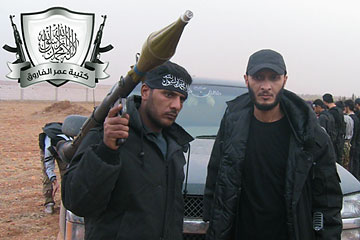
Khalid al-Hamad, left, in an undated photo that originally appeared on the website of the Syrian rebel group, the Independent Omar al-Farouk Brigade, which he commands.
(3 of 6)
The footage and photographs posted online also defy the facile explanation, often trotted out by analysts, that the anti-Assad forces can be divided into two camps, a majority of well-intentioned rebels and a minority of Islamists from al-Nusra Front, a terrorist group affiliated with al-Qaeda. Al-Hamad is neither: although he identifies himself as a member of the Salafist fundamentalist sect, he doesn't fight for al-Nusra. But the FSA, an umbrella group that claims to control 90% of the rebel fighters, including al-Hamad's brigade, wants no part of him either. Brigadier General Salim Idris, who heads the FSA's military command, had not yet seen the video when he spoke with TIME on the phone from his base in Turkey but said that "these kinds of behaviors, the cutting of bodies, is not allowed."
After the video was posted online, an FSA spokesperson portrayed al-Hamad as a regime stooge "pretending that he is in the FSA." But a spokesperson for the Syrian National Coalition, another umbrella group that works closely with the FSA, told TIME there was no doubt that al-Hamad's unit fell within the FSA. The coalition condemned al-Hamad's actions in a statement: "The FSA is a national army above all, formed to defend civilians and deliver the Syrian people from the mentality of revenge and crime. It completely rejects the ill treatment of the wounded and the disfigurement of the dead."
None of this consternation makes a jot of difference to al-Hamad, who argues that nobody outside the fight has the right to judge his actions. "You are not seeing what we are seeing, and you are not living what we are living," he says. Al-Hamad is especially contemptuous of anti-Assad groups that, like the leadership of the FSA, operate from outside Syria. "Hopefully [I will] slaughter them and eat their hearts as well," he says. As for his enemies on the battlefield, al-Hamad says he will soon release another gruesome video in which he claims to have cut up the body of another Assad soldier with a saw.
Online Eye for an Eye
Accounts of battlefield Atrocities have multiplied in recent months, according to the Syrian Observatory for Human Rights, but the sadistic tenor of this war was set in April 2011, just two months into the conflict, when a YouTube video showed the mutilated body of a 13-year-old protester who was apparently tortured and killed by Assad's security forces. The footage showed the body pockmarked with cigarette burns, bruises and bullet holes; the boy's neck and both kneecaps were broken, his penis severed. The video of the Boy Martyr Hamza, as he came to be widely known in the antiregime community, became a rallying cry for a popular uprising against a hated regime.
